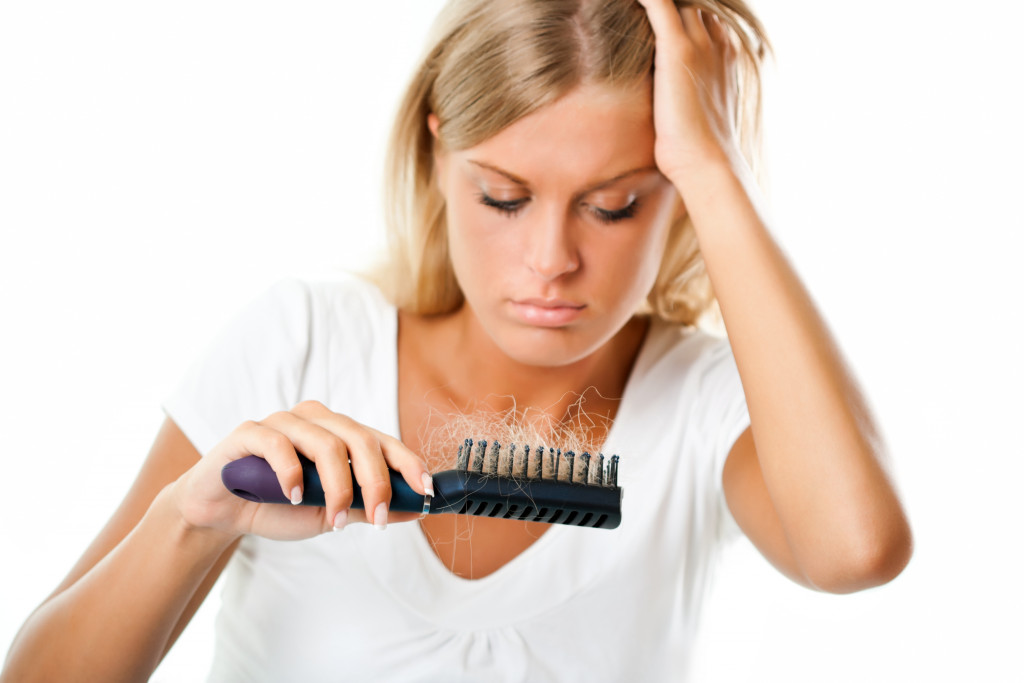There is a myth that only men with too much testosterone go bald. The reality is both men and women experience hair loss. Even heavily, sometimes. It is natural for both men and women to shed about 50 to 100 hair strands daily. Hairs fall out as new ones grow. But this natural shedding needs to be differentiated from alopecia or the loss of hair that’s not part of the natural regeneration balance.
Women may also suffer from alopecia. If you begin to notice bald spots, or that the partition in your hair is growing wider, or if you are shedding more than 100 hairs on a daily basis, it is likely that you are experiencing hair loss that’s not due to natural shedding. There are different classifications of hair loss, several symptoms and causes, and a few ways to cope with it.
Types of Hair Loss
Hair loss is classified into three types:
- Anagen effluvium: Growing hair follicles are poisoned by medications such as in chemotherapy.
- Telogen effluvium: There is an increase in hair follicles undergoing the fall-out stage referred to as the telogen phase.
- Androgenetic alopecia: It’s also known as FPHL or female pattern hair loss. This is when the hair on the top part of the head and the sides thin out.
Anagen effluvium hair loss happens during the hair’s growth stage and when a woman undergoes chemotherapy, radiation therapy, or takes certain potent medications. These substances cause abrupt hair loss on the head and other body parts. Anagen effluvium hair loss may be permanent when there is damage to the hair follicles.
Hair loss known as telogen effluvium is temporary and can be due to extreme stress on the body. Physical stress from childbirth, surgery, rapid weight loss, anemia, etc., can cause temporary hair loss. Emotional stressors, including loss of a loved one, mental illness, etc., can also affect hair loss. Shifts in hormone levels, such as in thyroid issues, pregnancy, and menopause, also contribute to this type of hair loss.
Female pattern hair loss (FPHL) can be caused by genetic factors, aging, and menopause. This is not reversible, although treatment can arrest the loss of hair or even stimulate new hair growth.
Alopecia areata is a medical condition that causes hair loss in patches on the head or other body parts. This type of hair loss is usually temporary.
Women at Risk of Hair Loss
Hair loss can affect any woman but is more common among women who:
- Are over 40
- Have just given birth
- Have just undergone chemotherapy and other medications
- Usually wear their hair pulled tightly (as in ponytails or braids)
- Use harsh hair chemicals
- Are in menopause
Hair Loss in Women: Common Symptoms and Causes
Symptoms of Hair Loss:
- Observing more fallen hair daily, either on floors, showers, pillows, or the hairbrush
- Noticeable patches of lost or thinned hair, particularly on the top part of the head
- Seeing your scalp through your hair
- Thinner ponytails
- Frequent hair breakage
Common Causes of Hair Loss:
- Frequently styling your hair in ways that pull on the hair roots, such as in tight ponytails, cornrows, or braids
- Damaged hair follicles that cause permanent hair loss.
- Vitamin deficiency
- Rapid weight loss
- Crash or unbalanced diets
- Use of harsh chemicals on hair that causes breakage
Preventing Hair Loss in Women
Hair loss caused by aging, heredity, and physical conditions such as disease or menopause cannot be prevented. This may be permanent or temporary. However, what you can prevent is hair loss caused by restrictive hairstyles, harsh chemicals, unbalanced diets, or smoking. Lifestyle changes may arrest some types of hair loss. Sticking to nutritious diets, avoiding stress, smoking, and harsh chemicals will help.
Coping With Hair Loss
If you are dealing with hair loss, there are certain things you can do for better-looking hair:
- Dyeing your hair visually adds volume, giving your hair a fuller appearance
- Gently massaging your scalp as you wash your hair stimulates blood flow
- Shorter, layered hairstyles can visually add volume
- Use sulfate-free shampoo and hair products
- Consult with a licensed aesthetic clinic if you suspect that a scalp condition causes your hair loss
The Bottom Line
Hair loss can happen to many women. Several factors contribute to hair loss in women, including heredity, medical conditions, medications, hormonal changes, stress, and lifestyle habits. You may need a professional opinion when figuring out the real cause of your hair loss. If you note excess hair loss, not due to the natural shedding process, speak to a medical professional for the proper diagnosis and treatment plan.
